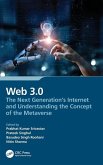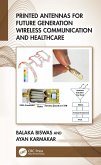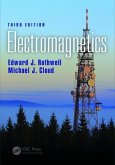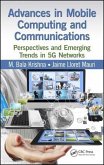5g and Beyond Wireless Communications
Fundamentals, Applications, and Challenges
Herausgeber: Bhowmick, Abhijit; Nallanathan, Arumugam; Singh, Indrasen; Kumar Choukiker, Yogesh
5g and Beyond Wireless Communications
Fundamentals, Applications, and Challenges
Herausgeber: Bhowmick, Abhijit; Nallanathan, Arumugam; Singh, Indrasen; Kumar Choukiker, Yogesh
- Gebundenes Buch
- Merkliste
- Auf die Merkliste
- Bewerten Bewerten
- Teilen
- Produkt teilen
- Produkterinnerung
- Produkterinnerung
This book provides a thorough introduction of 5G and Beyond 5G (B5G) wireless networks, as well as cutting-edge technologies that aid in network design and development. This book also covers machine learning techniques for advanced communications.
Andere Kunden interessierten sich auch für
![Cable and Wireless Networks Cable and Wireless Networks]() Mário Marques Da SilvaCable and Wireless Networks157,99 €
Mário Marques Da SilvaCable and Wireless Networks157,99 €![Millimeter Wave Communications in 5g and Towards 6g Millimeter Wave Communications in 5g and Towards 6g]() Vasanthan RaghavanMillimeter Wave Communications in 5g and Towards 6g160,99 €
Vasanthan RaghavanMillimeter Wave Communications in 5g and Towards 6g160,99 €![Web 3.0 Web 3.0]() Web 3.0132,99 €
Web 3.0132,99 €![Printed Antennas for Future Generation Wireless Communication and Healthcare Printed Antennas for Future Generation Wireless Communication and Healthcare]() Balaka BiswasPrinted Antennas for Future Generation Wireless Communication and Healthcare183,99 €
Balaka BiswasPrinted Antennas for Future Generation Wireless Communication and Healthcare183,99 €![Electromagnetics Electromagnetics]() Edward J RothwellElectromagnetics202,99 €
Edward J RothwellElectromagnetics202,99 €![Advances in Mobile Computing and Communications Advances in Mobile Computing and Communications]() Advances in Mobile Computing and Communications194,99 €
Advances in Mobile Computing and Communications194,99 €![Wireless Transceiver Circuits Wireless Transceiver Circuits]() Wireless Transceiver Circuits297,99 €
Wireless Transceiver Circuits297,99 €-
-
-
This book provides a thorough introduction of 5G and Beyond 5G (B5G) wireless networks, as well as cutting-edge technologies that aid in network design and development. This book also covers machine learning techniques for advanced communications.
Hinweis: Dieser Artikel kann nur an eine deutsche Lieferadresse ausgeliefert werden.
Hinweis: Dieser Artikel kann nur an eine deutsche Lieferadresse ausgeliefert werden.
Produktdetails
- Produktdetails
- Verlag: CRC Press
- Seitenzahl: 400
- Erscheinungstermin: 3. September 2024
- Englisch
- Abmessung: 234mm x 156mm x 22mm
- Gewicht: 735g
- ISBN-13: 9781032622569
- ISBN-10: 1032622563
- Artikelnr.: 70202811
- Herstellerkennzeichnung
- Libri GmbH
- Europaallee 1
- 36244 Bad Hersfeld
- gpsr@libri.de
- Verlag: CRC Press
- Seitenzahl: 400
- Erscheinungstermin: 3. September 2024
- Englisch
- Abmessung: 234mm x 156mm x 22mm
- Gewicht: 735g
- ISBN-13: 9781032622569
- ISBN-10: 1032622563
- Artikelnr.: 70202811
- Herstellerkennzeichnung
- Libri GmbH
- Europaallee 1
- 36244 Bad Hersfeld
- gpsr@libri.de
Abhijit Bhowmick received his BE (hons) degree in electronics and telecommunication engineering in 2002 from Burdwan University, West Bengal, India, and MTech degree in telecommunication engineering in 2009 and PhD in December 2016 from NIT Durgapur. He worked for Cubix Control System Pvt. Ltd. from 2004 to 2006. He joined the Department of Electronics and Communication Engineering, Bengal College of Engineering and Technology, Durgapur, as a lecturer in 2006. Thereafter, he joined VIT University, Vellore, TN, India, in the School of Electronics Engineering (SENSE) in June 2016 and is currently serving as an associate professor there. His research interests include cognitive radio networks, focusing on spectrum sensing and spectrum sharing issues, cooperative communications in cognitive radio networks, energy harvesting in wireless network, D2D communication, and physical layer security issues in wireless networks, and UAV-assisted communication. Yogesh Kumar Choukiker received his BE degree in 2007 and MTech and the PhD degrees from the National Institute of Technology, Rourkela, Orissa, India, in 2009 and 2014, respectively, both in electronics engineering. He is specialized in antenna and wave propagation. In particular, his research interest is microstrip antenna (fractal antennas) in the area of wireless application, MIMO environment, UWB, and reconfigurable fractal. He completed the ISRO RESPOND project in 2013, which is based on optimization techniques. At present, he has been working as a professor in Vellore Institute of Technology, Vellore, from January 2014. He was also a visiting research scholar in San Diego State University, California, USA, in his PhD. Indrasen Singh is working as an assistant professor (senior grade 2) in the Department of Embedded Technology under the School of Electronics Engineering (SENSE), Vellore Institute of Technology (VIT), Vellore, Tamil Nadu, India. He received his BTech and MTech degrees in electronics and communication engineering from Uttar Pradesh Technical University, Lucknow, India, in 2006 and 2010, respectively. He obtained his PhD degree in electronics and communication engineering from then National Institute of Technology Kurukshetra, Haryana, India, in 2019. He has qualified GATE examination many times. He has more than 15 years of teaching/research experience in the various reputed technical institutes/universities. He is supervising BTech, MTech, and PhD students. He is an editorial board member for AJECE, Science Publishing Group, USA. He is the reviewer of many SCI/SCOPUS-indexed international journals and served as TPC member and reviewer in different conferences. He has published more than 25 research papers in national/international journals/conferences of repute, and many are under review. His research interests are in the area of cooperative communication, stochastic geometry, modelling of wireless networks, heterogeneous networks, millimetre wave communications, device-to-device communication, machine learning, and 5G/6G communication. Arumugam Nallanathan is a professor of wireless communications and the founding head of Communication Systems Research (CSR) group in the School of Electronic Engineering and Computer Science at Queen Mary University of London (QMUL) from September 2017. He was with the Department of Informatics at King's College London from December 2007 to August 2017, where he was a professor of wireless communications from April 2013 to August 2017. He was an assistant professor in the Department of Electrical and Computer Engineering, National University of Singapore, from August 2000 to December 2007. His areas of interest are communication, stochastic geometry, modelling of wireless networks, heterogeneous networks, millimetre wave communications, device-to-device communication, and 5G/6G communication.
Chapter 1
A Comprehensive Research Look of Opportunities and Challenges in Advanced Wireless Communication Chapter 2
Opportunities and Challenges in Advanced Wireless Communication Chapter 3
Millimeter Wave for Next
Generation Networks: Opportunities, Challenges, and Possible Solutions Chapter 4
Cognitive Radio: A Key Enabling Technology for 5G and Beyond Communication Chapter 5
Device
to
Device Communication: Cooperative Device
to
Device Communication Chapter 6
UAV
Assisted Communication: Unmanned Aerial Vehicles in Vehicle
To
Everything Communication Networks Chapter 7
A Flight from 5G to 6G with UAV
Enabled Communications: A Case Study Chapter 8
Development and Analysis of an RF
Powered Rechargeable Wireless Sensor Network for LR
WPAN Chapter 9
Cooperative NOMA with Hybrid PTS
Based Energy Harvesting Relay Chapter 10
Full
Duplex Energy Harvesting
Based Cooperative NOMA Network Chapter 11
Design of Efficient Signal Detection Schemes for Large
Scale MU
MIMO System Chapter 12
Flexible Antennas
A New Frontier in 5G Technology: A Review Chapter 13
Flexible MIMO Antennas for UWB applications Chapter 14
Design of Inset
Fed Microstrip Patch Antenna Using Surrogate Model
Assisted Differential Evolution Chapter 15
Millimetre Wave Antenna Design For 5G Applications Chapter 16
Machine Learning Algorithms for Optimization and Intelligence in Wireless Networks: WSNs, MANETs, VANETs, and USNs Chapter 17
An Efficient Localization for Resource Management in UAV
Assisted Wireless Networks Using Deep Learning Chapter 18
A Smartphone Based Context
Aware Driver Rating System for Cities in Developing Economies
A Comprehensive Research Look of Opportunities and Challenges in Advanced Wireless Communication Chapter 2
Opportunities and Challenges in Advanced Wireless Communication Chapter 3
Millimeter Wave for Next
Generation Networks: Opportunities, Challenges, and Possible Solutions Chapter 4
Cognitive Radio: A Key Enabling Technology for 5G and Beyond Communication Chapter 5
Device
to
Device Communication: Cooperative Device
to
Device Communication Chapter 6
UAV
Assisted Communication: Unmanned Aerial Vehicles in Vehicle
To
Everything Communication Networks Chapter 7
A Flight from 5G to 6G with UAV
Enabled Communications: A Case Study Chapter 8
Development and Analysis of an RF
Powered Rechargeable Wireless Sensor Network for LR
WPAN Chapter 9
Cooperative NOMA with Hybrid PTS
Based Energy Harvesting Relay Chapter 10
Full
Duplex Energy Harvesting
Based Cooperative NOMA Network Chapter 11
Design of Efficient Signal Detection Schemes for Large
Scale MU
MIMO System Chapter 12
Flexible Antennas
A New Frontier in 5G Technology: A Review Chapter 13
Flexible MIMO Antennas for UWB applications Chapter 14
Design of Inset
Fed Microstrip Patch Antenna Using Surrogate Model
Assisted Differential Evolution Chapter 15
Millimetre Wave Antenna Design For 5G Applications Chapter 16
Machine Learning Algorithms for Optimization and Intelligence in Wireless Networks: WSNs, MANETs, VANETs, and USNs Chapter 17
An Efficient Localization for Resource Management in UAV
Assisted Wireless Networks Using Deep Learning Chapter 18
A Smartphone Based Context
Aware Driver Rating System for Cities in Developing Economies
Chapter 1
A Comprehensive Research Look of Opportunities and Challenges in Advanced Wireless Communication Chapter 2
Opportunities and Challenges in Advanced Wireless Communication Chapter 3
Millimeter Wave for Next
Generation Networks: Opportunities, Challenges, and Possible Solutions Chapter 4
Cognitive Radio: A Key Enabling Technology for 5G and Beyond Communication Chapter 5
Device
to
Device Communication: Cooperative Device
to
Device Communication Chapter 6
UAV
Assisted Communication: Unmanned Aerial Vehicles in Vehicle
To
Everything Communication Networks Chapter 7
A Flight from 5G to 6G with UAV
Enabled Communications: A Case Study Chapter 8
Development and Analysis of an RF
Powered Rechargeable Wireless Sensor Network for LR
WPAN Chapter 9
Cooperative NOMA with Hybrid PTS
Based Energy Harvesting Relay Chapter 10
Full
Duplex Energy Harvesting
Based Cooperative NOMA Network Chapter 11
Design of Efficient Signal Detection Schemes for Large
Scale MU
MIMO System Chapter 12
Flexible Antennas
A New Frontier in 5G Technology: A Review Chapter 13
Flexible MIMO Antennas for UWB applications Chapter 14
Design of Inset
Fed Microstrip Patch Antenna Using Surrogate Model
Assisted Differential Evolution Chapter 15
Millimetre Wave Antenna Design For 5G Applications Chapter 16
Machine Learning Algorithms for Optimization and Intelligence in Wireless Networks: WSNs, MANETs, VANETs, and USNs Chapter 17
An Efficient Localization for Resource Management in UAV
Assisted Wireless Networks Using Deep Learning Chapter 18
A Smartphone Based Context
Aware Driver Rating System for Cities in Developing Economies
A Comprehensive Research Look of Opportunities and Challenges in Advanced Wireless Communication Chapter 2
Opportunities and Challenges in Advanced Wireless Communication Chapter 3
Millimeter Wave for Next
Generation Networks: Opportunities, Challenges, and Possible Solutions Chapter 4
Cognitive Radio: A Key Enabling Technology for 5G and Beyond Communication Chapter 5
Device
to
Device Communication: Cooperative Device
to
Device Communication Chapter 6
UAV
Assisted Communication: Unmanned Aerial Vehicles in Vehicle
To
Everything Communication Networks Chapter 7
A Flight from 5G to 6G with UAV
Enabled Communications: A Case Study Chapter 8
Development and Analysis of an RF
Powered Rechargeable Wireless Sensor Network for LR
WPAN Chapter 9
Cooperative NOMA with Hybrid PTS
Based Energy Harvesting Relay Chapter 10
Full
Duplex Energy Harvesting
Based Cooperative NOMA Network Chapter 11
Design of Efficient Signal Detection Schemes for Large
Scale MU
MIMO System Chapter 12
Flexible Antennas
A New Frontier in 5G Technology: A Review Chapter 13
Flexible MIMO Antennas for UWB applications Chapter 14
Design of Inset
Fed Microstrip Patch Antenna Using Surrogate Model
Assisted Differential Evolution Chapter 15
Millimetre Wave Antenna Design For 5G Applications Chapter 16
Machine Learning Algorithms for Optimization and Intelligence in Wireless Networks: WSNs, MANETs, VANETs, and USNs Chapter 17
An Efficient Localization for Resource Management in UAV
Assisted Wireless Networks Using Deep Learning Chapter 18
A Smartphone Based Context
Aware Driver Rating System for Cities in Developing Economies



